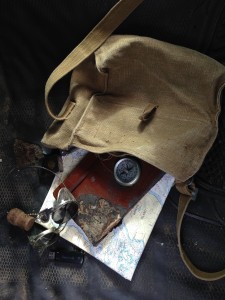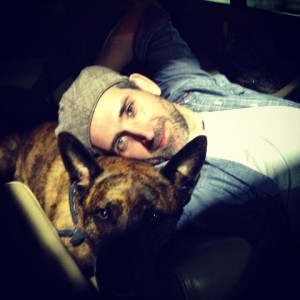Sedona AZ (November 26, 2014) – The following has been taken from Collins Rhōg’s private journal, and reproduced exactly as it was written, by his own hand. The date has been omitted, at his request, but Collins view is always captivatingly honest, full of depth and color, heart, love, and perseverance in times of struggle. Collins spills his soul and captures his feelings with vivid imagery and heart felt emotion that oozes from the pages of this historic text.
The following is but a portholes view, from across the room of “The Life and Times of Collins Rhōg“:
If you are new to the story, it all begins at this link (click here). In previous weeks, our readers were introduced to Rhog’s story as written in his journal. Join us as we return to the Life and Times of Collins Rhōg, now 38, while he surveys the gates of Hell:
– Cambire, The Story Part 9 –
The next morning I woke, sensing the presence of the cave’s ghost; a peaceful entity skulking about.
“Could it sense me the same?”
Morning’s tea blazed through the remainder of the cheese puffs. Savoring that last cup, my hands absorbed the mug’s hot intensity while I assessed my dwindling supplies. I would be departing the following day as planned.
Quenching restlessness found me reorganizing everything in the camp. I cleaned out the Land Cruiser and repacked it all, neatly preparing for departure. Once finished straightening, I noticed Shugo’s eyes yearning for some exercise and decided to head up the canyon to scout an old battle site that I’d never explored.
Grabbing a rope, my knife, and Sarah along with five rounds not counting the one in her chamber, I hopped off of the shelf, onto the truck, and then to the Canyon floor, with Shugo on my six. The Land Cruiser fired up with a rumble that rebounded down the canyon as Shugo paced atop the seat, preparing to ride shotgun. We lumbered several miles upstream, until the narrowing walls prevented the Toyota’s passage. Hoofing it from there, Shugo scouted ahead, tail raised, ears articulating with nose to the ground.
The canyon floor was mostly clear of debris and fairly smooth from last year’s runoff. I always loved this area, having spent a dozen of my childhood summers working with my brother on our uncle’s cattle ranch not far from the canyon. After an hour on foot, we came upon a long pocket of water trapped within a natural cistern that was shaded from the sun. Kneeling down to drink from the clear, tranquil pool, I watched Shugo bound in beside me, hesitant to enter beyond his shoulders. Shugo would advance, halt and then retreat, pawing at the surface in an attempt to burrow beneath it. In and out of the hidden pool, he turned towards me, stop to shake as water flared from his body while his torment remained. A moment later found the pooch chest deep, once more.

Cambire, The Story
I called to Shugo while hiding behind a boulder. Looking up, Shugo froze in attentiveness and all was quiet. The cloud slid off the sun and everything brightened. I could see his nose twitching in Morse code as his ears tightened their aim at the boulder that hid me. Then, as if someone had fired a starting pistol in a silent film, Shugo propelled from the pool, a cruise missile in a low altitude intercepting trajectory with me in his sights. Water streamed off of his coat like flowing tinsel in a wind tunnel. Sprinting downstream to escape, my Legionaries Palladium boots skimmed the earth, which felt like soft butter. I poured it on for roughly 100 yards, expecting to see Shugo overtake me…but he didn’t. Looking back, my lead on the hound had lengthened. I began to laugh uncontrollably and slowed down to land. Shugo came barreling in at full speed, beaming his shit grin that exposed those formidably large canine teeth now grabbing at my pant leg. I fell into the sandy canyon floor, as Shugo ambushed me with hysterical yelping. He climbed all over me as my heart raced with joy and complete exhaustion.
We continued our trek, happy to be exploring and free of any concerns. In those moments my past didn’t exist, the package I had smuggled into the country didn’t exist, the sheer beauty of nature’s solitude posses those moments entirely…it was enchanting. Farther upstream, the Canyon turned into a gulch, which turned into a runnel, and then into a rill that is born at the base of a natural amphitheater. It was this amphitheater, with rugged surrounding ridges and no apparent means of egress, that forty-five Cavalry soldiers went from hunters to hunted by the same Braves who they were pursuing. The Native Americans had long used this canyon as an escape route from the Cavalry, and even the Spaniards before that.
The story told by Tucker Manfield around a campfire, thirty years prior, had always remained in my memory. Tuck, my uncle’s friend, was ninety-eight at the time, and still made his living as a trapper and prospector until he died in his sleep the next Christmas. It was the information I gathered from the stories that Tuck shared, along with other research, that led me to the Canyon where I discovered the Moonshiners Cave.
Tuck had learned of the soldiers slaughter from a Nez Perce Elder. The Elder and the Trapper had traded for years and were almost friends. While Tuck never made it to the amphitheater, the story along with his other tales always fascinated me. It’s amazing how much information is lost forever when one of these old timers passes away.
It all happened in 1877, when the U.S. Army under Colonel Nelson A. Miles command was pursuing the Nez Perce who had been joined by bands of the Palouse. The U.S. Army had been chasing these Native Americans for over 1,000 miles and, time and time again, the non-treaty Nez Perce outmaneuvered the military as they attempted to reach the Canadian border.
Forty-three men of the 3rd U.S. Cavalry along with two Scouts pursued forty non-treaty Nez Perce warriors who had gone to several ranches and stolen horses. The Native Americans left the area with seven dead ranchers in their dust. The pursuing men from the 3rd Cavalry were well armed bringing with them seven mules, three of which shared the load of a formidable 12-pound Mountain Howitzer. Hot on the trail, the two Army scouts discovered the Native warriors resting along the bench of a river, but by the time they returned with soldiers the warriors were gone.
The Scouts tracked the Native Americans for three days, following them into the same canyon that held my ELUP. The Cavalry chased the warriors up the canyon, and all the way into the amphitheater, but the Native Americans preceded their pursuers by several minutes. Tuck told me that there is a large boulder, near the back of the amphitheater, shaped like a giant hand with its fingers together, pointing straight up. This boulder marks the way out of the amphitheater…the Native Americans and Spaniards knew this, but the U.S. Cavalry did not.
Apparently, using the hand shaped boulder and their lead on the Cavalry, the Native Americans exited the amphitheater, made for high ground and split up, taking gun positions along each side of the ridge. The Cavalry, unable to see any of the Native Americans positions, stood little chance. The warriors viewed the Army’s arrival from 75-150 feet above them, behind the protection of the large boulders and rocks that hid their presence. The soldiers stopped below the braves, thinking it was a dead end, with uneasy horses they bunched together and scanned the ridges, searching for the exit route. Their mules, at the end of the line, were blocking a retreat out the entrance to the amphitheater through which they had advanced.
The Captain, screaming at his men, was pulling hard left on his reins, turning his horse in circles while looking up at the ridge that surrounded them. The crack of rifle fire erupted above the Calvary from three sides, knocking them down like ripe apples dropping from an overladen tree in a stiff wind. Within seconds of the Native Americans fierce attack on the soldiers, three of the men, who must have realized the situation, made a run for the entrance of the amphitheater. Two were gunned down almost immediately, while the third neared his escape and would have made it had his horse not been shot dead.
Whatever troops remained dismounted and took up positions in the rocks, but by this time over two thirds of their comrades were either dead or dying. The entrenched soldiers found temporary protection from the Nez Perce’s hail of bullets, but their numbers were small and, the fact that they were split up and pinned down, left them no chance of laying down any kind of suppression fire that would allow an overlapping retreat.
The Native Americans took their time picking off the surviving Cavalry men who hunkered down listening to the wailing cries of their dying comrades suffering. As the day grew later the moaning ceased, and the sun climbed higher over an atmosphere of silent uneasiness. The stillness was broken by the occasional crack of a rifle echoing from above, indicating that another one of their servicemen had met his death, and that their chance of survival narrowed that much more.
By nightfall a mere five soldiers from the 3rd Calvary remained alive at the bottom of the amphitheater. It was nearly a full moon, providing so much light that one’s shadow could be seen and so could the sights on the end of the rifles that held a commanding view of everything in the amphitheater. The Nez Perce were able to effectively shoot anything that moved below them.
Four of the soldiers tried to escape in the night and three were killed in their attempts. Dawns first light revealed just two soldiers alive, out of the original forty-five men who had ridden into the amphitheater the previous day. That day was long and hot and the two soldiers were deteriorating fast with no food, no water, and no sleep to refresh their bodies.
The Cavalry men waited out the heat, hiding, praying, thinking about their loved ones. With little ammunition remaining the sun beat down on them relentlessly, then, late in the afternoon, one of the soldiers caught sight of an overeager Nez Perce brave who had carelessly moved positions, revealing himself. The serviceman leaned up, raising his model 1865 Spencer Carbine to his cheek. Trying to steady himself, he carefully placed the brave between his sights. Another Native American saw what was taking place and fired at the soldier, missing by about a foot. The soldier held his prone position to ensure the kill shot, acquired it, and squeezed the trigger. The rifle howled as the soul fell dead. Another shot at the soldier from above missed, and the Cavalry man hunkered back down out of the line of fire.
That second night, cloud cover blanketed the sky providing a chance for the two soldiers to crawl through the darkness unseen by the Nez Perce. But the darkness allowed the Native Americans to move about unseen as well, and while the soldiers were crawling towards the entrance of the amphitheater, the braves were climbing down to finish the job.
The soldiers met the Nez Perce at the bottom of the amphitheater and another gun battle erupted. Having nothing to lose, the soldiers fought with everything they had, killing two and wounding two others before running out of ammunition. With no more rounds between them the outcome for the remaining Cavalry men was inevitable, and both soldiers were feverishly gunned down in short order.
Shugo and I hiked upstream on the dry bed for an almost two hours until we came to the amphitheater, which was just as Tuck had described it. Looking around, one could logically determine where events took place and how dire the Cavalry soldiers must have felt. After several minutes of poking around, I began to find spent shell casings…several .50 caliber rounds, a few .45 caliber rounds and one .54 caliber round ball that was probably fired from a model 1841 Springfield Rifle, a muzzle loader that saw extensive use during the Mexican-American War. At one spot, Shugo bounded over several dozen bullet strikes in a group of three large boulders, and I knew that there must have been a desperate soldier pinned down beneath them.
A narrow channel, roughly twelve feet long and five feet wide separated the boulders, and provided about four feet of walled protection. I climbed into the channel realizing that the spot was likely last occupied by a Union soldier. I tried to imagine the man pinned in that very spot…what would he have done…and took up a defensive position. I wondered what role that man played in the fight and decided, from the thorough protection of the boulders, that he had to be one of the souls who either died trying to escape beneath the moonlit night, or he was one of the last two who fought to the end. I sat behind the stone walled fortress gazing at the same surroundings that soldier last viewed.
With the day spent, we headed back to the Land Cruiser. Approaching the pocket of water on our return, Shugo broke into a trot. This time Shugo had something to prove as he bound straight into the pool and began to swim. That dog must have reflected while we were exploring all day. He must have regretted not overcoming his fear of the clear fluid captured within the rock formation. Shugo became a fish in water, swimming to the middle of the cistern, where he continued in circles for several minutes. Coming out of the pool Shugo looked up and grinned at me. I praised him and let him be a dog as he turned and bounded back into the water, tail arched over his back and ever so present in the moment. It was a great way to spend our last day in the canyon. With a little luck, we’d be at my cabin the next day and continue on from there in my PA-18 aircraft.
– Collins Rhōg
Cambire, The Story continues in the SedonaEye.com.

For the best Arizona news and views, read www.SedonaEye.com daily!



liked that bit of history
quite interesting, chaptering good idea, happy holiday